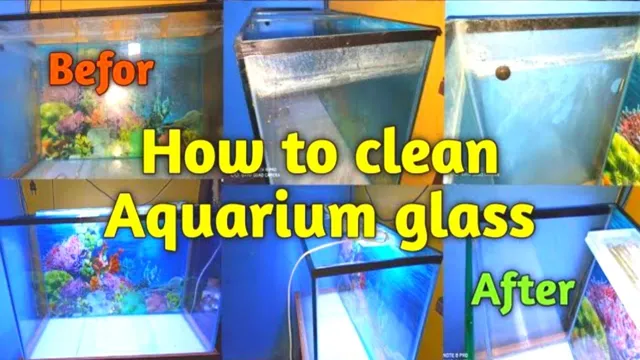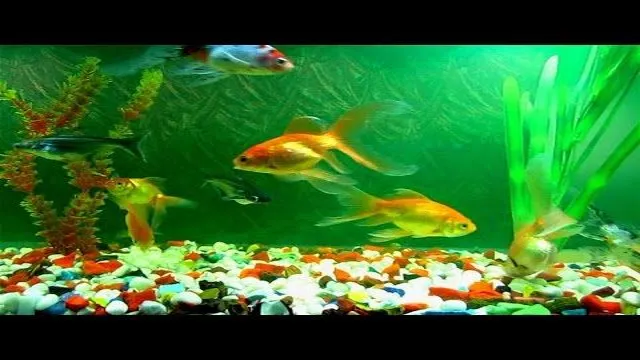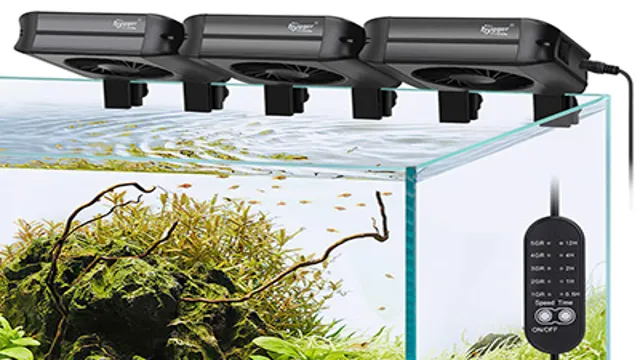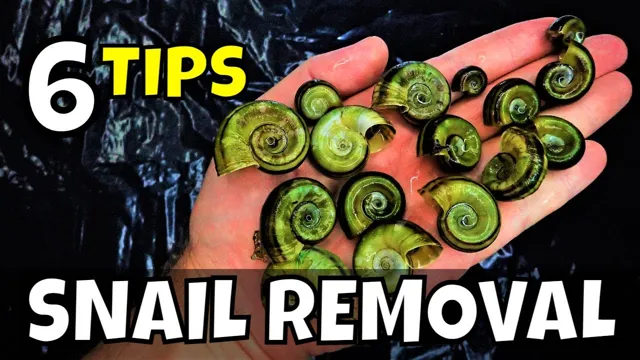Aquariums are a great way to bring a bit of the underwater world into your home. They provide a calming and relaxing atmosphere and can be an excellent addition to any room. However, one of the most common problems aquarium enthusiasts face is water stains.
These stains can be unsightly and can detract from the overall beauty and aesthetic of the aquarium. Luckily, there are several ways to clean aquarium water stains and make your tank look brand new. In this blog post, we will explore some of the best methods for cleaning aquarium water stains, so you can spend less time worrying about how your tank looks and more time enjoying your fish.
Understanding the Causes of Aquarium Water Stains
Aquarium water stains can be frustrating to deal with, especially when they make your beautiful aquatic displays look unsightly. These stains can be caused by a number of factors including algae growth, hard water buildup, and mineral deposits. If you’re struggling to get rid of these stains, there are a few things you can try.
Cleaning your aquarium regularly is one of the most effective ways to prevent stains from forming. You can also try using a specialized aquarium cleaner or a mixture of vinegar and water to remove stubborn stains. Another important thing to do is to make sure your aquarium’s water chemistry is balanced, as this can help to prevent stains from forming in the first place.
With the right approach, it’s possible to keep your aquarium looking beautiful and free from stains.
High pH Levels in Aquarium Water
Aquarium Water Stains Have you noticed unsightly stains in your aquarium water? High pH levels could be the culprit. Aquarium water stains can be caused by a variety of factors, including excess nutrients, poor water circulation, and inadequate filtration. However, one of the most common causes of aquarium water stains is a high pH level.
This can occur when your aquarium water becomes too alkaline and can lead to the formation of calcium deposits and other mineral deposits on the glass or walls of your tank. High pH levels can also cause stress to your aquatic plants and fish, which can lead to potential health problems. It’s important to regularly test and monitor your aquarium’s water quality to ensure that the pH levels are at a safe and healthy range for your aquatic pets.
Proper maintenance and regular water changes can also help to prevent stains and maintain a healthy aquatic environment. So, keep an eye on the pH levels in your aquarium and make adjustments as necessary to keep your aquarium water pristine and your aquatic pets happy and healthy.
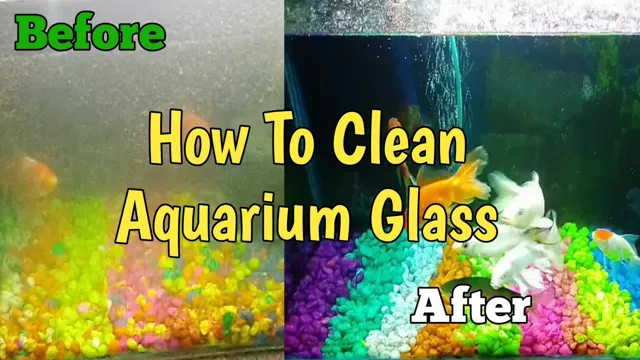
Fish Waste and Debris Buildup
Fish waste and debris buildup can cause unsightly stains in your aquarium water. If you notice discoloration or cloudiness in your tank, it’s likely due to the accumulation of leftover food, excrement, and other organic matter that aren’t removed during regular cleaning. This buildup can create a breeding ground for harmful bacteria and algae, which can be detrimental to your aquatic pets’ health.
To prevent aquarium stains, it’s essential to establish a regular cleaning routine that includes the removal of excess food and waste and the use of quality filtration systems. Additionally, you can add live aquarium plants and beneficial bacteria to help break down waste and keep your aquarium clean. By following these steps, you can keep your aquarium water clean and healthy for your fish to thrive.
Preventative Measures to Avoid Water Stains
Aquariums make beautiful and fascinating additions to any space, but they can require a little extra maintenance to keep them looking their best. One common issue aquarium owners face is water stains on the glass, which can be unsightly and difficult to remove. The best way to avoid water stains is to take preventative measures, such as ensuring that the water level in the tank is always below the top edge of the glass and using a high-quality water conditioner to keep the water balanced and free of contaminants.
Additionally, regularly cleaning your aquarium and its components can help prevent algae and mineral buildup that lead to water stains. If you do notice water stains, there are a few DIY solutions you can try, such as using vinegar or baking soda to scrub the glass, but using a specialized aquarium glass cleaner may be your best bet for easy and effective cleaning. By taking these preventative measures and regular cleaning your aquarium, you can keep your tank looking beautiful and free of water stains.
Frequent Water Changes
Frequent water changes are essential if you want to prevent water stains in your home. This simple and preventative measure can save you a lot of money, time, and hassle in the long run. If you leave water sitting in a container for an extended period, it can cause discoloration, mineral buildup, or even mold growth.
By changing your water regularly, you can avoid these problems and keep your home looking clean and fresh. It’s important to not only change the water in your vase or aquarium but also in your appliances, such as your humidifier or air conditioner. In doing so, you can ensure that you’re maintaining the quality of your home’s water supply, which could impact your health.
Don’t wait until you start seeing water stains to take action, start implementing frequent water changes today, and enjoy a stain-free home! (See Also: How to Properly Heat a 55 Gallon Aquarium: Tips and Techniques for Optimal Temperature Control)
Regular Tank Maintenance
How can you prevent unsightly water stains in your fish tank? Regular maintenance is key. First, make sure to clean your tank’s filter at least once a month. A clogged filter can lead to stagnant water, which is a breeding ground for bacteria and can cause stains.
Additionally, regularly test your water quality to ensure that levels of ammonia, nitrite, and nitrate are in check. High levels of these chemicals can cause discoloration and other issues in your tank. Finally, consider adding live plants to help absorb excess nutrients and reduce the chances of staining.
By taking these preventative measures, you can keep your tank looking clean and healthy for your fish to thrive in. So, why not make tank maintenance a regular part of your routine?
Proper Filter Maintenance
One of the best ways to avoid water stains is to perform proper filter maintenance. Over time, filters can become clogged with dirt, debris, and other particles, reducing their effectiveness and potentially allowing water stains to develop. Regularly cleaning or replacing your filters is an important preventative measure that can help avoid these issues and keep your water clean and clear.
Additionally, it’s important to choose the right filter for your specific needs and to use it properly, following manufacturer instructions and guidelines. By taking proactive steps to maintain your filters, you can help ensure that your water remains clean and free of unsightly stains. So, the next time you start seeing water stains around your home, consider checking and servicing your filters before they lead to bigger problems.
Cleaning Aquarium Water Stains
If you have an aquarium, you may have noticed water stains on the glass. These unsightly stains are caused by minerals and other impurities in the water, and they can be difficult to remove. But don’t worry – there are ways to clean aquarium water stains.
One effective method is to use white vinegar. Simply mix equal parts white vinegar and water in a spray bottle, spray the solution onto the glass, and let it sit for a few minutes. Then, use a clean cloth to wipe away the stains.
Another option is to use a commercial aquarium cleaning solution. These products are formulated specifically for cleaning aquarium glass and can be found at pet stores or online. Whichever method you choose, be sure to rinse the glass thoroughly with fresh water before filling the aquarium back up.
With a little bit of effort, you can have a clean and clear aquarium that you can enjoy for years to come.
Using Vinegar to Clean Water Stains
If you’re a fan of aquariums, then you know how unsightly water stains can be. Luckily, vinegar is an excellent solution to this issue. It’s natural, affordable, and effective – all the reasons you need to ditch harsh chemicals and switch to vinegar for cleaning your aquarium water stains.
Simply mix equal parts of water and vinegar and apply it to the affected area. Let it sit for a few minutes, and then scrub with a soft-bristled brush. Rinse thoroughly with water, and you’ll have a clean and sparkling aquarium in no time.
Plus, vinegar is a great alternative to chemical-based cleaners that can harm your fish and plants. With vinegar, you can achieve a clean and safe environment for your beloved aquarium, promoting the health of your aquatic pets. So, the next time you notice water stains in your aquarium, give vinegar a try, and see the magic unfold before your eyes.
Using Baking Soda to Clean Water Stains
If you’re an aquarium owner, you know how frustrating it can be to deal with water stains on the glass. Not only do they make it harder to see your fish friends, but they also make your tank look less attractive overall. Luckily, there’s a simple solution – baking soda! Baking soda is a natural cleaning agent that can effectively remove water stains without harming your aquarium or the fish inside.
To use it, simply mix a small amount of baking soda with water to create a paste, then apply it to the stained areas using a soft cloth. Rub gently in a circular motion, then rinse thoroughly with water. You’ll be amazed at how clean and clear your aquarium glass looks! Plus, this method is much more cost-effective than buying expensive aquarium cleaning products. (See Also: How to Get Diatoms Out of Aquarium: Tips and Tricks for a Crystal Clear Tank)
Give it a try and see the results for yourself!
Removing Stubborn Stains with a Razor Blade
Aquarium water stains can be quite stubborn and difficult to remove. If you’ve tried all the methods you know but still can’t get rid of the stubborn stains, then perhaps it’s time to use a razor blade. Don’t worry, you won’t be damaging the glass of the aquarium, as long as you use the blade carefully.
Before you start scraping away at the stains, ensure that the blade is sharp enough to do the job. Also, make sure that you angle the blade properly to prevent any scratches on the glass. Gently scrape away at the stains, always using a light and steady hand.
Be patient and avoid rushing through the process, as it can damage the glass or leave scratches. Once you’ve removed the stains, use a soft cloth to wipe down the glass. The result should be a crystal-clear aquarium that looks as good as new.
Keep in mind that safety is key, so always handle the razor blade with care and caution. By following these tips, you can get your aquarium looking spotless and beautiful in no time.
Keeping Your Aquarium Water Crystal Clear
Keeping your aquarium water crystal clear is crucial for the health and happiness of your fish. One common issue with aquariums is water stains, which can make the tank look dirty and unsightly. To remove these stains, start by doing a partial water change and using a gravel vacuum to suck up any debris at the bottom of the tank.
Then, use a special aquarium glass cleaner to wipe down the sides of the tank. Be sure to only use products that are safe for fish and won’t harm the delicate balance of your aquarium’s ecosystem. Additionally, regularly replacing your filter cartridge and cleaning your aquarium’s decorations can help prevent future stains from forming.
With a few simple steps and routine maintenance, you can keep your aquarium’s water looking clean and clear for your fish to thrive in.
Regular Tank Cleaning Schedule
Maintaining a regular tank cleaning schedule is essential to keeping your aquarium water crystal clear and your fish healthy. Over time, debris can accumulate on the bottom of the tank and waste products can build up, causing ammonia levels to rise and water quality to deteriorate. To prevent this from happening, it’s important to clean your tank every two to three weeks.
Start by removing any uneaten food, dead plants, and debris from the bottom of the tank. Next, use a siphon to remove about 25% of the water and replace it with fresh, dechlorinated water. Be sure to clean the filtration system as well to remove any buildup.
By maintaining a regular cleaning schedule, you’ll be able to enjoy a beautiful, healthy aquarium for years to come!
Proper Feeding Schedule and Portions
Proper feeding schedule and portions are key to maintaining a crystal clear aquarium. Overfeeding can lead to cloudy water and an unhealthy environment for your fish. It’s important to understand the dietary needs of each species of fish and to feed them accordingly.
Some fish may require multiple small meals throughout the day, while others may only need to be fed once or twice a day. It’s also important to monitor the amount of food given to each fish and remove any uneaten food to prevent it from decomposing and polluting the water. By keeping a consistent feeding schedule and portioning out the food correctly, you can keep your aquarium water clear and healthy for your fish to thrive in.
Remember, a little goes a long way in the world of fish feeding! (See Also: How to Make a Living off Breeding Aquarium Fish: Tips and Tricks for Profitable Fish Breeding)
Regular Water Testing and Monitoring
Regular water testing and monitoring is essential to maintaining a healthy and thriving aquarium. It is crucial to keep your aquarium water crystal clear by conducting regular water tests to check for any changes in pH levels, ammonia, nitrite, and nitrate levels. These parameters can indicate the overall health of your aquarium and its inhabitants.
Neglecting to monitor the water quality can result in a buildup of toxins that can harm your fish and other aquatic creatures. Therefore, investing in a reliable water testing kit and monitoring your water quality weekly is highly recommended. Think of it as checking the vital signs of your fish and aquarium environment, just as you would for your pet’s health.
By regularly testing and monitoring your aquarium water, you can prevent any potential problems and ensure a healthy and happy aquatic habitat.
Conclusion
In conclusion, cleaning aquarium water stains is not only important for aesthetic purposes, but it also helps maintain the health of your aquatic buddies. With a bit of elbow grease and a few household items, you can easily banish those stubborn water marks and restore the sparkle to your fish tank. So, don’t let those stains be a fishbowl eyesore any longer, go ahead and give your aquarium the TLC it deserves!”
FAQs
What causes water stains in an aquarium?
Water stains in an aquarium are usually caused by hard water. This means that the water contains high levels of minerals such as calcium and magnesium.
How can I prevent water stains in my aquarium?
To prevent water stains in your aquarium, you should use a water softener or a water conditioner. You can also use distilled water for your aquarium.
How do I clean water stains from my aquarium glass?
To clean water stains from your aquarium glass, you can use a mixture of vinegar and water. Simply spray the mixture onto the glass and wipe it clean with a cloth.
Can water stains harm my aquarium fish?
Water stains are generally harmless to aquarium fish. However, if the water stains are caused by an excess of minerals in the water, this can affect the pH levels and cause stress to your fish.
How often should I clean my aquarium to prevent water stains?
You should clean your aquarium regularly to prevent water stains. This includes cleaning the glass, the gravel, and the decorations. It’s recommended to do a partial water change every week and a full clean every month.
Should I use chemicals to clean my aquarium water stains?
It’s not recommended to use chemicals to clean your aquarium water stains as they can be harmful to your fish. Stick to natural remedies such as vinegar and water.
How can I maintain a clean aquarium to prevent water stains?
To maintain a clean aquarium and prevent water stains, make sure to feed your fish the right amount of food, avoid overstocking your tank, and do regular water changes. You should also clean your filter regularly.

